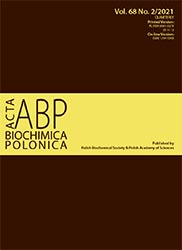miREIA - an immunoassay method in assessment of microRNA levels in tumor tissue-pilot study. The impact of miR-93-5p, miR-142-5p and IFNγ on PD-L1 level in colorectal cancer
Abstract
Colorectal cancer (CRC) is the second and third most common cancer in females and males, respectively. The PD-L1/PD-1 immune checkpoint is an important source of immunosuppression in the tumor microenvironment and is associated with IFNγ. Recent studies revealed that a significant number of tumor-suppressive miRNAs can regulate the expression of PD-L1. The objective quantification of selected microRNAs using the miREIA method in CRC tissue was performed. We investigated the role of miR-93-5p and miR-142-5p expression and the levels of IFNγ in regulating the expression of PD-L1 in tumor and margin tissues of CRC in relation to the histological grade, TNM classification, and tumor localization. 37 samples of tumor and margin tissues from CRC patients were evaluated. MiR-93-5p and miR-142-5p levels were measured using a novel method for the quantitative measurement of human microRNA (miREIA). The concentrations of PD-L1 and IFNγ were determined using ELISA kits. We found higher concentrations of miR-93-5p, PD-L1, and IFNγ in tumor samples compared to the tumor margin samples. A significant correlation was found between PD-L1 and IFNγ levels in tumor and margin specimens; between miR-142-5p and miR-93-5p levels in tumor and margin specimens. A higher level of miR-93-5p was found in tumor margin tissues on the left side of the colon. Patients with distant metastases were characterized by higher miR-93-5p concentration compared to patients without metastases. CRC is an important source of PD-L1, IFNγ, and miR-93-5p expression. Understanding the mechanisms underlying intratumoral PD-L1 expression may create new opportunities for targeted immunotherapy of colorectal cancer.
Acta Biochimica Polonica is an OpenAccess quarterly and publishes four issues a year. All contents are distributed under the Creative Commons Attribution-ShareAlike 4.0 International (CC BY 4.0) license. Everybody may use the content following terms: Attribution — You must give appropriate credit, provide a link to the license, and indicate if changes were made. You may do so in any reasonable manner, but not in any way that suggests the licensor endorses you or your use.
Copyright for all published papers © stays with the authors.
Copyright for the journal: © Polish Biochemical Society.


